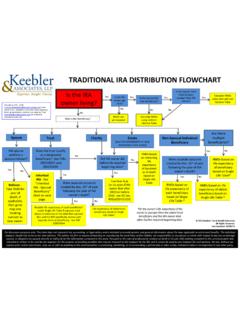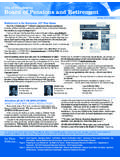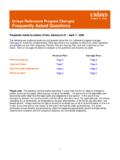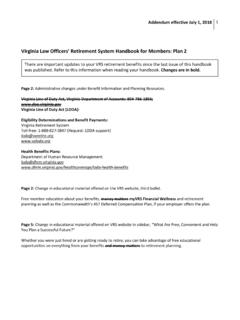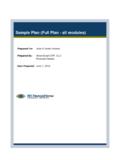Transcription of Asset Protection Planning to Keep Creditors and Predators ...
1 JOURNAL OF retirement PLANNING53 September October 2007 2007 KeeblerRobert S. Keebler, CPA, , is a Partner with Virchow, Krause & Company, LLP, in Green Bay, Protection Planning to keep Creditors and Predators at BayBy Robert S. Keebler*In the past 36 months, more and more clients seem to be asking about Asset Protection Planning . Although we can speculate about the genesis of these questions, it is likely that as clients pay less and less attention to the estate tax, clients and lawyers alike are addressing the brutal reality of Creditors and Predators and how to protect themselves, their children and their most families, the best Asset Protection begins with insurance and a substantial umbrella policy. Additionally, the utilization of well-drafted trusts for lifetime gifts and transfers upon death provide signifi -cant Asset Protection . The concept of a spendthrift trust is simple and discussed the use of insurance and spendthrift trusts, bankruptcy and Asset Protection attorneys often rely upon Employee retirement Income Security Act of 1974 ( ERISA )1 plans, exemptions for IRAs, foreign Asset Protection trusts, family limited partnerships, domestic Asset Protection trusts, Code Sec.
2 529 plans, annuities and of course the Homestead exemption for Asset , however, Asset Protection must focus on compartmentalizing risk by using LLCs, S corpora-tions, C corporations and limited partnerships with a corporate partner. For example, for a client with 100 apartment buildings, it would be wise to hold these buildings in a series of LLCs. That way, if a judgment occurs, the damage will be limited to the LLC that owns the particular building where the injury or other tort liability matter the Asset Protection vehicles chosen by the client, it should be stressed that time is of the essence when dealing with Asset Protection Planning . Due to the fraudulent transfer laws, Planning which occurs too late ( , too close in time to the happening of a poten-tially negative event) can be considered fraudulent and disregarded for Asset Protection purposes. Therefore, clients will best protect themselves and their assets by Planning early and Planning often!
3 The following summary will provide an overview of each of the above mentioned Asset Protection ve-hicles. Furthermore, Planning strategies will also be presented to help facilitate understanding and enable to reader to best assist their Insurance Coverage The Primary DefenseAs adequate insurance coverage is generally a fam-ily s fi rst and principal defense against liability claims and judgments, it is logical that an effective Asset Protection plan generally begins with having the proper insurance coverage in place. Normally, this means having an umbrella policy to supplement the family s business, professional liability, homeowner s and automobile insurance policies. For a relatively nominal cost, umbrella policies typically offer from $1 million to $50 million in additional coverage. Although not effective as an Asset Protection tool against all types of liabilities and losses, when used in concert with other Asset Protection measures, umbrella insurance policies are generally an extremely successful and cost ef-fective measure.
4 Especially considering the immense fi nancial expense and exposure an underinsured individual and their family may be faced with. Utilizing Trusts for Asset Protection PurposesTrusts have a long history as Asset Protection instru-ments and vehicles through which to insulate assets 54 2007 CCH. All Rights garner Protection from creditor s claims. Today, the utilization of trusts as Asset Protection tools has expanded and increased. In addition to the popular spendthrift trusts, individuals can now consider imple-menting foreign Asset Protection trusts and possibly even domestic Asset Protection trusts. However, the ef-fectiveness of some of these newer trusts is not certain and the Protection offered by may come at a and Self-Settled TrustsA spendthrift trust is one of the most effective and most commonly utilized Asset Protection vehicles. It is similar to a traditional trust except for the addition of a restraint on alienation or spendthrift clause.
5 This clause gives the trust its Asset Protection features basically by providing that the undistributed principal and income of the trust shall not be subject to the claims of any of the benefi ciary s Creditors . These trusts are generally effective and upheld under state and federal laws if designed to protect the interests of the benefi ciaries. In comparison, spendthrift trusts designed to protect the interests of the settlor are termed self-settled trusts. In these trusts, due to the fact that the settlor is one of the benefi ciaries of the trust, they may be ineffective at providing Asset Protection for the set-tlor s assets. Accordingly, spendthrift trusts, which are ideal for making lifetime gifts and transfers upon death, should generally be established only to protect the interests of a benefi ciary such as a spouse, child or grandchild and not those of the Asset Protection TrustsAlthough a self-settled trust may be a legitimate trust, unless it is established as a domestic Asset Protection trust in one of the few jurisdictions which have en-acted domestic Asset Protection statutes, the trust will generally be ineffective for Asset Protection Domestic Asset Protection trusts are basically self-settled trusts enacted in domestic jurisdictions which have en-acted the requisite legislation.
6 Furthermore, due to the fact that domestic Asset Protection trusts are relatively new, there has been no litigation either upholding or defeating their validity or effectiveness. Therefore, it is generally believed that these types of trusts will currently be most effective for individuals residing in jurisdictions which have enacted domestic Asset Protection legisla-tion. Furthermore, it may be wise to pursue the counsel of an Asset Protection attorney prior to considering or enacting one of these new Offshore: Foreign Asset Protection TrustsAlthough domestic Asset Protection trusts are relatively new, the idea of going offshore and placing assets in foreign Asset Protection trusts is a commonly utilized, sophisticated Asset Protection strategy. Foreign Asset Protection trusts generally provide strong Asset pro-tection due to their establishment under the laws and jurisdictions of foreign countries which have more favorable Asset Protection and privacy measures, and which typically do not enforce judgments.
7 Thus, even if a creditor is successful in attaining a judgment against a debtor, the creditor will probably have a dif-fi cult time, and suffer fi nancial detriment, enforcing the judgment against a debtor s assets that are housed in a foreign Asset Protection trust. However, these trusts are not without their risks and uncertainties. The very features that make offshore trusts successful Asset Protection vehicles also make them risky. In order to mitigate these risks, it may be benefi cial to maintain more control over the trust assets placed in a foreign Asset Protection trust. To accomplish this goal, family limited partnerships (FLPs) or limited liability companies (LLCs) may be used in tandem with foreign Asset Protection trusts. In order for the settlor to retain control over the transferred assets while relinquishing ownership of the assets, generally the settlor either owns a minimal general partnership interest in the FLP, with the trust owning the limited partnership interests; or the settlor is named as the manager of the LLC with the trust owning the LLC interests.
8 While the utilization of FLPs and LLC in tan-dem with offshore trusts is a complex Asset Protection strategy, it can also produce benefi cial results. However, as with domestic Asset Protection trusts, offshore trusts are best utilized after thorough counsel with an Asset Protection attorney, and only after the indi-vidual fully understands the possible risks as well as the benefi ts associated with this Asset Protection strategy Federal Laws Providing Asset Protection for Assets in Qualifi ed Plans and IRAsThe Employee retirement Income Security Act of 1974 (ERISA)3 and the Bankruptcy Abuse Prevention and Con- Asset Protection Planning to keep Creditors and Predators at BayJOURNAL OF retirement PLANNING55 September October 2007sumer Protection Act of 2005 ( the Bankruptcy Act )4 are the two main bodies of federal law that provide Asset Protection for qualifi ed plan and IRA assets.
9 ERISA, which applies to assets within covered em-ployer retirement plans, is the primary federal law under which qualifi ed plan assets receive Asset pro-tection. Although not all encompassing, for covered assets, the Protection provided by ERISA is virtually impenetrable and takes the favorable form of an ex-clusion from the federal bankruptcy estate. In order to receive Protection under ERISA, the retirement plan must be a covered plan and fall under the scope of ERISA regulation. The covered employee retirement plans which are regulated by ERISA, and are conse-quently afforded ERISA Protection , include 401(k) and 403(b) plans, defi ned benefi t plans, money-purchase plans and profi t-sharing plans. retirement plans such as Traditional IRAs, Roth IRAs, SEP and SIMPLE IRAs, and single participant ( , husband and/or wife) retirement plans for self employed busi-ness owners, which are not covered by ERISA, are not afforded Protection under ERISA.
10 Additionally, ERISA Protection is generally applicable independent of whether the debtor has fi led for second body of federal law affording Asset Protection to retirement plan assets is the recently enacted Bankruptcy Act. Simplifying and expanding the Asset Protection available for both ERISA and non-ERISA retirement plan assets5 of debtors in bankruptcy, the Bankruptcy Act provides Asset Protection in the form of an exemption form the bankruptcy estate. Most signifi cantly, the Bankruptcy Act codifi ed the previously uncertain federal Asset Protection afforded Traditional and Roth IRA the Bankruptcy Act, creditor Protection is now extended to all IRA accounts irregardless of state law. Presently, the Bankruptcy Act provides an un-limited exemption from the bankruptcy estate for all rollover IRAs and SEP and SIMPLE IRAs. Additionally, contributory IRAs ( , Traditional IRA or Roth IRA) are afforded Protection in the form of a $1 million exemption, which may be increased if the interests of justice PointDue to the $1 million limitation placed on contribu-tory IRA Protection , it is always desirable to keep contributory IRAs and rollover IRAs separate.



